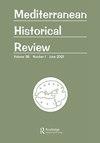The Greek revolution: a critical dictionary
IF 0.2
2区 历史学
Q1 HISTORY
引用次数: 5
Abstract
1. A pioneering study which generated much debate is Reşat Kasaba, Çağlar Keyder, and Faruk Tabak, “Eastern Mediterranean port cities and their bourgeoisies: merchants, political projects, and nation-states,” Review (Fernand Braudel Center) 10, no. 1 (1986): 121–135. 2. See, for example, Jens Hanssen, Thomas Philipp, and Stefan Weber (eds.), The empire in the city: Arab provincial capitals in the late Ottoman Empire (Würzburg: Ergon Verlag, 2002); Marie-Carmen Smyrnelis (ed.), Smyrne, la ville oubliée: mémoires d’un grand port ottoman, 1830–1930 (Paris : Éditions Autrement, 2006); Sibel Zandi-Sayek, Ottoman Izmir: the rise of a cosmopolitan port, 1840–1880 (Minneapolis: University of Minnesota Press, 2012); Meltem Toksöz and Biray Kolluoğlu (eds.), Cities of the Mediterranean: from the Ottomans to the present day (London: I.B. Tauris, 2014); Will Hanley, Identifying with nationality: Europeans, Ottomans, and Egyptians in Alexandria (New York: Columbia University Press, 2017). 3. See, for example, Ilham Khuri-Makdisi, The Eastern Mediterranean and the making of global capitalism, 1860–1914 (Berkeley: University of California Press, 2010); Julia A. ClancySmith, Mediterraneans: North Africa and Europe in the age of migration, c. 1800–1900 (Berkeley: University of California Press, 2011); Judith E. Tucker (ed.), The making of the modern Mediterranean: views from the south (Berkeley: University of California Press, 2019).希腊革命:批判词典
1.一项引起广泛争论的开创性研究是Reşat Kasaba、ÇAğlar Keyder和Faruk Tabak,“东地中海港口城市及其资产阶级:商人、政治项目和民族国家”,评论(Fernand Braudel Center)10,第1期(1986):121-135。2.例如,参见Jens Hanssen、Thomas Philipp和Stefan Weber(编辑),《城市中的帝国:奥斯曼帝国晚期的阿拉伯省会》(维尔茨堡:Ergon Verlag,2002);Marie Carmen Smyrnelis(编辑),Smyrne,la ville oubliée:mémoires d‘un grand port ottoman,1830-1930(巴黎:Éditions Autrement,2006);Sibel Zandi Sayek,《奥斯曼帝国伊兹密尔:国际港口的崛起》,1840–1880(明尼阿波利斯:明尼苏达大学出版社,2012);Meltem Toksöz和Biray Kolloğlu(编辑),《地中海城市:从奥斯曼人到今天》(伦敦:I.B.陶里斯,2014);Will Hanley,《认同国籍:亚历山大的欧洲人、奥斯曼人和埃及人》(纽约:哥伦比亚大学出版社,2017)。3.例如,参见Ilham Khuri Makdisi,《东地中海与全球资本主义的形成》,1860–1914(伯克利:加州大学出版社,2010);Julia A.ClancySmith,《地中海人:移民时代的北非和欧洲》,约1800–1900年(伯克利:加州大学出版社,2011年);Judith E.Tucker(编辑),《现代地中海的形成:南方的观点》(伯克利:加州大学出版社,2019)。
本文章由计算机程序翻译,如有差异,请以英文原文为准。
求助全文
约1分钟内获得全文
求助全文

 求助内容:
求助内容: 应助结果提醒方式:
应助结果提醒方式:


